3. Trading Call Options

(1). Call Option

Call Option is the right to buy something (= underlying asset).
If you are trading call options on equities (common stocks), it means you are trading the rights to buy the stocks on a certain day for a certain price.
If you are trading call options on equities (common stocks), it means you are trading the rights to buy the stocks on a certain day for a certain price.
| Example of Call Option on Stocks | ||

|

|

|
|
Strike Price: $10 Premium: $1 Expiration: October 1 |
||

The above example of a call option shows the right to buy certain stocks for $10.
This price for which the option gives you the right to buy is called Strike Price.
The price of the option itself also has a name -- Premium.
Additionally, every option has Expiration.
For the above example, the expiration date is set to be October 1.
In summary, this call option is "the right to buy the stocks for $10 per share on October 1".
This price for which the option gives you the right to buy is called Strike Price.
The price of the option itself also has a name -- Premium.
Additionally, every option has Expiration.
For the above example, the expiration date is set to be October 1.
In summary, this call option is "the right to buy the stocks for $10 per share on October 1".
Note: In the real market
There are two basic styles of options with regard to how the right is exercised -- American-style and European-style.
Although the options on stocks are American-style in the real stock market in America, we apply European-style options to the examples to facilitate learning.
Although the options on stocks are American-style in the real stock market in America, we apply European-style options to the examples to facilitate learning.

So an option has three things.
Strike Price, Premium, and Expiration. Am I correct?
Strike Price, Premium, and Expiration. Am I correct?

Yes. Let's take a look at how traders buy and sell the call option.
Suppose that the stock is trading at $9.5 on September 1 when the option is traded.
Suppose that the stock is trading at $9.5 on September 1 when the option is traded.
Trade Date: September 1
|
Underlying Asset

|
||
|
Buyer

- $1
A buyer of the call pays $1 for the price (or premium) of the option.
|


Strike Price: $10
Premium: $1 Expiration: October 1 |
Seller

+ $1
A Seller of the call receives $1 for the price (or premium) of the option.
|
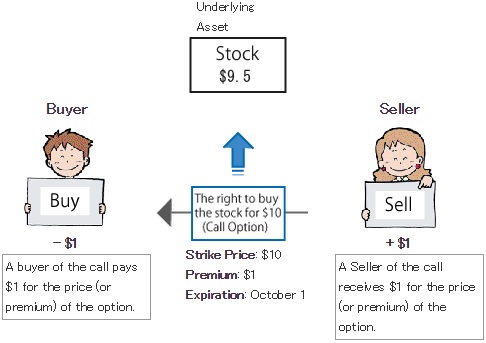

In this example, the call option was traded for $1 on September 1.

This option's strike price is $10 and the expiration date is October 1.
So the buyer of the option bought "the right to buy the stock at the price of $10 on October 1". Am I correct?
So the buyer of the option bought "the right to buy the stock at the price of $10 on October 1". Am I correct?

That's right.
Here, you need to know the difference between the buyer and the seller of options.
A call option gives the buyer the right, but not the obligation, to buy an underlying asset at the strike price.
On the other hand, the seller of a call option has the obligation to sell an underlying asset at the strike price when the buyer exercises the option.
Here, you need to know the difference between the buyer and the seller of options.
A call option gives the buyer the right, but not the obligation, to buy an underlying asset at the strike price.
On the other hand, the seller of a call option has the obligation to sell an underlying asset at the strike price when the buyer exercises the option.

A buyer has the right. A seller has the obligation...
But wait a minute!
I don't understand selling a option. Where does the option come from in the first place? Do you have to borrow it from a broker like you borrow the stocks when going short??
But wait a minute!
I don't understand selling a option. Where does the option come from in the first place? Do you have to borrow it from a broker like you borrow the stocks when going short??

When you sell an option, you don't need either have it or borrow it from anyone.
In other words, you can sell what you don't have in options trading.
This may sound strange at first, but think about what insurance companies do. They write the contract of insurance out of nothing and sell it to their customers.
As a result, insurance companies receive insurance premiums, but they have to pay the cost of losses when something goes wrong.
The contract of options is basically the same. A seller can just "write" (which is an alternative term for "sell") options out of nothing, with the obligation to pay the cost when the price of the underlying asset moves against the position.
In other words, you can sell what you don't have in options trading.
This may sound strange at first, but think about what insurance companies do. They write the contract of insurance out of nothing and sell it to their customers.
As a result, insurance companies receive insurance premiums, but they have to pay the cost of losses when something goes wrong.
The contract of options is basically the same. A seller can just "write" (which is an alternative term for "sell") options out of nothing, with the obligation to pay the cost when the price of the underlying asset moves against the position.

That sounds interesting. I want to know more about trading.

OK. Let't see what happened one month after the above trade.
The result can be summed up simply as follows.
The result can be summed up simply as follows.
- The buyer wins and the seller loses if the stock price rises above $11.
- The seller wins and the buyer loses if the stock price stays below $11.
Case 1: The Stock Price is above $11 on October 1
|
The stock price is
$12 on Exp. Day

|

Stock Price Rose |
|
|
Buyer

+ $1
The buyer has the right to buy the stock for $10 which is trading at $12 in the market.
If he exercises the right to buy the stock and sell it immediately, he can gain $2. His total gain is $1 since he initially paid $1 for the premium of the option. |


Strike Price: $10
Premium: $2 Expiration: October 1 |
Seller

- $1
The seller has the obligation to deliver the stock as the buyer exercises the option.
So she must sell the stock for $10 which is trading at $12 in the market, which causes her $2 loss. Her total loss is $1 since she initially received $1 for the premium of the option. |
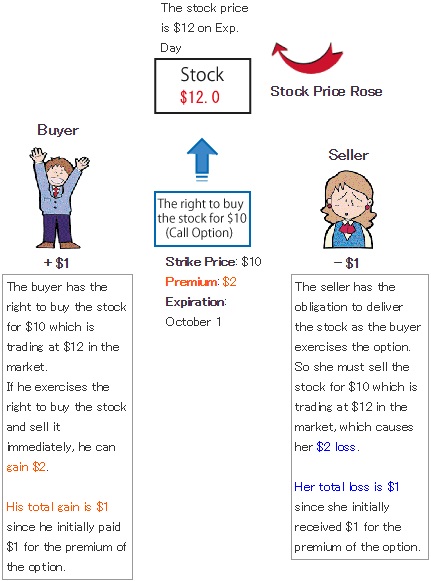

As you can see, the buyer wins and the seller loses if the price of the stock (underlying asset) rises sufficiently before the expiration day.
Note: In the real market
In the real stock market, 1 call option contract gives you the right to buy 100 shares of stock.
So the buyer of the example would gain $200 in the real market as a result of buying 100 shares of stock for $10 per share (which is $1,000 in total) and then selling them for $1,200. His total gain would be $100 because he initially would have paid $100 for the option. ($1 * 100 shares)
Similarly, the total loss of the seller would be $100 in the real market.
So the buyer of the example would gain $200 in the real market as a result of buying 100 shares of stock for $10 per share (which is $1,000 in total) and then selling them for $1,200. His total gain would be $100 because he initially would have paid $100 for the option. ($1 * 100 shares)
Similarly, the total loss of the seller would be $100 in the real market.

I guess I got hold of the trade.
But buyers of options don't always win, do they?
But buyers of options don't always win, do they?

In fact they don't.
Now let's see the case where the stock price didn't rise after the first option trade.
Now let's see the case where the stock price didn't rise after the first option trade.
Case 2: The Stock Price is below $11 on October 1
|
The stock price
stayed flat...

|
||
|
Buyer

- $1
The call option has no value at this point because no one wants to pay $10 for what anyone can buy at $9.5 in the market.
He can just let it expire worthless. His total loss is $1 since he initially paid $1 for the premium of the option. |


Strike Price: $10
Premium: $0 Expiration: October 1 
This option has expired worthless.
|
Seller

+ $1
The seller doesn't have to do anything because the call option has expired worthless.
Her total gain is $1 since she initially received $1 for the premium of the option. |
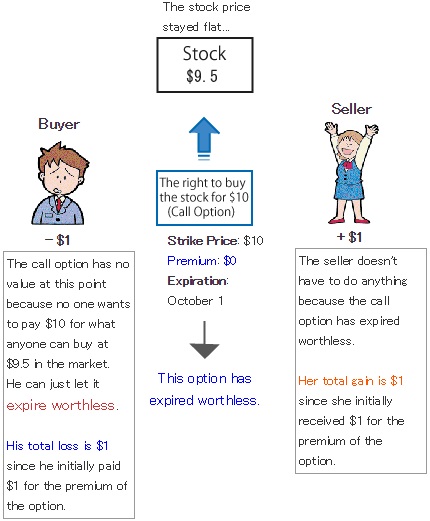

The buyer of the option has "the right to buy the stock for $10", but the stock price didn't changed from $9.5 since the option was initially traded.
Who wants to exercise the call option and pay $10 for the stock that anyone can buy for $9.5 in the market?
So the buyer can just let the call option expire worthless because a buyer of options has the right, not the obligation, to buy underlying assets at the strike price.
Who wants to exercise the call option and pay $10 for the stock that anyone can buy for $9.5 in the market?
So the buyer can just let the call option expire worthless because a buyer of options has the right, not the obligation, to buy underlying assets at the strike price.

The call option was initially bought for the premium of $1, but it turned out to be $0 or worthless on the expiration day.
That's why the buyer of the option lost money in this trade.
That's why the buyer of the option lost money in this trade.

You are right.
The seller is able to keep $1 which was initially gained by selling the option, finishing the trade with $1 profit.
The seller is able to keep $1 which was initially gained by selling the option, finishing the trade with $1 profit.
(2). Quick Summary -- Profit and Loss

In the above example, $11 (for the stock price) is the break-even point on the expiration day for both the buyer and the seller of the call option .
Let's take a look at the profit/loss graph for the buyer.
 P/L graph for the buyer
P/L graph for the buyer
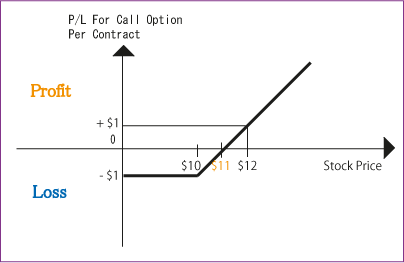
Let's take a look at the profit/loss graph for the buyer.
 P/L graph for the buyer
P/L graph for the buyer


It looks like the loss is limited to the initial premium.
But the profit can be larger as the stock price rises.
But the profit can be larger as the stock price rises.

In summary, the purchase of a call option has the following possibility:
 P/L graph for the seller
P/L graph for the seller
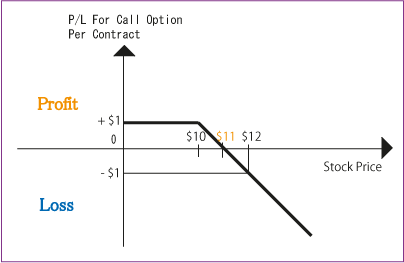
- Unlimited profit potential and limited loss potential
 P/L graph for the seller
P/L graph for the seller


The profit is limited to the option premium, but the loss seems to have no limits if the underlying asset surges.

The seller of a call option has exactly the opposite possibility to the buyer:
The above graph shows that the seller can gain profit even if the stock price doesn't change.
As I mentioned in the 1st lesson "Advantages of Options", this is one of the biggest advantages in options trading -- making profits in sideways markets.
- Unlimited loss potential and limited profit potential
The above graph shows that the seller can gain profit even if the stock price doesn't change.
As I mentioned in the 1st lesson "Advantages of Options", this is one of the biggest advantages in options trading -- making profits in sideways markets.

I remember that. There is no way to make money in sideways markets if you just trade stocks.

There is even more in selling options. When you sell an option, you can make a profit even if the price of underlying asset moves against your position as long as the movement is small.
In the above example, the seller can gain a profit even when the stock price rises as long as it doesn't surpass $11.
In the above example, the seller can gain a profit even when the stock price rises as long as it doesn't surpass $11.

I understand your point. But buying options seems more reasonable. When you buy an option, your risk is limited and you have unlimited profit potential.

That is one of the most misunderstood concepts in options trading.
The fact is, however, it is hard to say which side is better, buying or selling, because "the chance of winning" in selling options is much higher than that in buying.
There are statistics showing that 80% of options traded in the market expire worthless.
One way to put it is that buyers of options lose their money in most trades, but they occasionally make a fortune with a profit many times larger than their initial investment.
Sellers can often earn profits, but in the event of market crashes or some other wild movements of the underlying asset, they may suddenly lose all that they have gathered little by little.
If you want to play the game of options well, it is important to find "an edge" in trading.
The fact is, however, it is hard to say which side is better, buying or selling, because "the chance of winning" in selling options is much higher than that in buying.
There are statistics showing that 80% of options traded in the market expire worthless.
One way to put it is that buyers of options lose their money in most trades, but they occasionally make a fortune with a profit many times larger than their initial investment.
Sellers can often earn profits, but in the event of market crashes or some other wild movements of the underlying asset, they may suddenly lose all that they have gathered little by little.
If you want to play the game of options well, it is important to find "an edge" in trading.
(3). You Can Resell Options

We have only looked at the cases where the buyer kept the call option until the expiration date to exercise it.
What if, however, the stock price surged before the expiration and the buyer wanted to "realize" a profit beforehand?
In such case, the value (premium) of the option rises, so you can just resell it and gain a profit.
What if, however, the stock price surged before the expiration and the buyer wanted to "realize" a profit beforehand?
In such case, the value (premium) of the option rises, so you can just resell it and gain a profit.

|

|
As the stock price rises... |

|

|
The value of the option rises as well. |

Really? So I can make money before the expiration day?

Yes, you can.
In fact, buyers of options benefit from reselling them when the premium gets higher rather than just waiting until the expiration date to exercise them.
The reason was discussed in Advantages of Options -- the advantage of leverage. You need small amount of asset to make a large profit.
Another reason is related to "the time value of options" which we will learn in the later lesson.
In fact, buyers of options benefit from reselling them when the premium gets higher rather than just waiting until the expiration date to exercise them.
The reason was discussed in Advantages of Options -- the advantage of leverage. You need small amount of asset to make a large profit.
Another reason is related to "the time value of options" which we will learn in the later lesson.

So traders buy and sell options. Now we are talking Option Trading!

Remember that it's up to you wheather you exercise an option and trade underlying assets or buy and sell options themselves. You have a wide range of options in options trading.
From sellers' points of view, they may want to avoid facing the exercise of options after the stock price surges. In this case, the sellers can buy the options back before the expiration date and offset their positions.
Unfortunately, sellers will suffer losses because the premium of the option is already higher as a resul of the rise in the stock price. But buying back is often necessary for them to keep the loss under control and manage the risk.
From sellers' points of view, they may want to avoid facing the exercise of options after the stock price surges. In this case, the sellers can buy the options back before the expiration date and offset their positions.
Unfortunately, sellers will suffer losses because the premium of the option is already higher as a resul of the rise in the stock price. But buying back is often necessary for them to keep the loss under control and manage the risk.

I've heard risk management is vital in trading.

That's it for Call Option.
You certainly learned A LOT in this lesson. I appreciate your heavy work!
The next lesson is Put Option. It will be A LOT easier than this time, for the only difference is "selling" the underlying asset instead of "buying".
You certainly learned A LOT in this lesson. I appreciate your heavy work!
The next lesson is Put Option. It will be A LOT easier than this time, for the only difference is "selling" the underlying asset instead of "buying".

Yes, sir.
I hope it will, sir.
I hope it will, sir.

